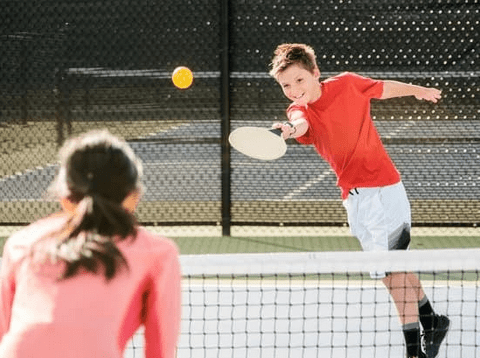Pickleball Rules: Understanding the Basics
Are you new to pickleball? Looking to learn the basic rules of this fast-growing sport? In this beginner's guide to pickleball, we will help you understand the fundamental rules that govern the game. Whether you are playing indoors or outdoors, knowing the rules is essential for fair play and an enjoyable pickleball experience.

According to the Sports & Fitness Association, pickleball has gained nearly 40% in popularity over the past two years. Played on a court with a 34-inch net in the middle, it combines elements of tennis, ping pong, and badminton. The equipment required is minimal—just a paddle and a ball with holes in it.
Understanding the basic rules of pickleball is crucial for playing the game correctly. It involves underhand serving, scoring to 11 points, and following the two-bounce rule. Whether you are a beginner or an experienced player, having a good grasp of the rules will enhance your pickleball skills and overall enjoyment of the sport.
Key Takeaways:
- Pickleball is the fastest-growing sport in the US, with a nearly 40% rise in popularity.
- The game is played with a paddle and a ball with holes, on a court with a 34-inch net.
- Pickleball combines elements of tennis, ping pong, and badminton.
- The basic rules include underhand serving, scoring to 11 points, and the two-bounce rule.
- Understanding the rules is essential for fair play and an enjoyable pickleball experience.
Recent Featured Articles:
How to Improve Your Pickleball Serve: Techniques and Drills
Learn How to Play Pickleball: A Comprehensive Guide
Pickleball for Kids: A Fun and Active Sport for YoungstersWhat is Pickleball?
Pickleball is a unique paddle sport that combines tennis, ping pong, and badminton elements. It is played on a court with a 34-inch net in the middle and can be enjoyed indoors and outdoors. Pickleball is popular for people of all ages and skill levels, offering a fun and engaging way to stay active.
In pickleball, the objective is to hit a lightweight ball over the net and into the opponent's court using a paddle. The serve is done underhand, and players must stay within certain court boundaries. The equipment required for pickleball is minimal, consisting of a pickleball paddle and a specialized ball with holes.
Learning to play pickleball is relatively easy, making it accessible for beginners. The game follows a set of basic rules, including the two-bounce rule, where the ball must bounce once on each side of the net before players can volley it. This rule adds an interesting dynamic to the game, requiring players to strategize and anticipate their opponent's moves.
Whether you're looking to improve your fitness, socialize with friends, or compete in pickleball tournaments, understanding the basics of pickleball is essential. In the following sections, we will delve deeper into the specific rules and regulations of pickleball, including court rules, serving rules, scoring rules, and more.
Pickleball Court Rules
Pickleball courts have specific rules and layouts that players must adhere to for fair gameplay. Understanding these court rules is crucial for playing the game correctly. Here are the key rules and layout guidelines for a standard pickleball court:
Court Layout
The pickleball court is rectangular, measuring 20 feet wide and 44 feet long for both singles and doubles play. The court is divided into different sections, each serving a specific purpose:
- Baseline: The back boundary line of the court.
- Sidelines: The lines running along the sides of the court.
- Centerline: The line that divides the court into two halves.
- Non-Volley Zone (Kitchen): The area on both sides of the net, extending 7 feet from the net. Players are not allowed to volley the ball within this zone.
Line Rules
The lines on the pickleball court serve specific purposes and help determine the boundaries and positions of the players:
- Baseline: The baseline is the back boundary line of the court. All serves must be made behind this line.
- Sidelines: The sidelines determine the boundaries of the court. All shots must be made between the sidelines.
- Centerline: The centerline divides the court into two halves. It is used to determine the serving and receiving areas.
- Non-Volley Zone Line: The non-volley zone line, also known as the kitchen line, marks the boundary of the non-volley zone (kitchen). Players are not allowed to volley the ball within this zone.
Knowing the placement and purpose of these lines is essential for playing by the rules of pickleball and ensuring a fair and enjoyable game.
Pickleball Serving Rules
Understanding the serving rules of pickleball is essential for a fair and successful game. Here are the key rules to keep in mind:
Underhand Serve:
In pickleball, the serve must be performed underhand. This means that the server must swing their paddle with an upward motion, making contact with the ball below their waist. The underhand serve helps maintain fairness and prevents players from gaining an unfair advantage through power serves.
Serving Position:
The server must stand behind the baseline while serving. It is important to maintain this position until the ball is struck. Stepping on or over the baseline before making contact with the ball is considered a fault. This rule ensures that the server does not gain an advantage by moving closer to the net before serving.
Diagonal Serve:
The server must hit the ball diagonally across the net. For example, if you are serving from the right-hand side of the court, your serve should cross over to the left-hand side of the opponent's court. This rule encourages strategic gameplay and prevents the server from targeting a specific opponent.
Faults and Penalties:
Several faults can occur during the serve, resulting in penalties. Some common faults include serving out of bounds, into the net, or into the non-volley zone. If a fault is committed, the serve is lost, and the opposing team gains the opportunity to serve. Understanding and avoiding these faults is crucial for a fair and enjoyable game.
Now that you have a solid understanding of the serving rules in pickleball, you can confidently step onto the court and play the game with skill and fairness. Practice your underhand serve, stay within the serving position, and aim for a diagonal shot to keep the game exciting and competitive. Enjoy the thrill of pickleball while abiding by the serving rules to ensure a fun and fair experience for all players.
Pickleball Scoring Rules
Pickleball scoring follows a unique system that adds to the excitement and fast-paced nature of the game. When playing pickleball, points are scored only by the serving team. The game is typically played to 11 points, with a two-point advantage required to win. Both singles and doubles games follow the same scoring rules, ensuring consistency and fairness.
One of the key features of pickleball scoring is the rally scoring system. Unlike traditional scoring systems where only the serving team can score, rally scoring allows points to be scored by both teams, regardless of who serves. This means that every rally has a chance to impact the score, keeping players engaged and on their toes throughout the game.
In pickleball, the serving team has the opportunity to score a point if the receiving team commits a fault, such as hitting the ball out of bounds or into the non-volley zone. However, if the serving team commits a fault, the receiving team not only gains the serve but also has the opportunity to score a point. This back-and-forth scoring system adds an element of strategy and pressure to the game, as players must balance scoring points with avoiding faults.
| Pickleball Scoring Rules | |
|---|---|
| Rally Scoring | Points can be scored by both teams, regardless of who serves |
| Game Length | Played to 11 points, with a two-point advantage required to win |
| Serving Team | Only the serving team has the opportunity to score points |
By understanding the scoring rules of pickleball, players can strategize and adapt their gameplay accordingly. The rally scoring system keeps the game dynamic and highly competitive, while the requirement for a two-point advantage adds extra intensity. So whether you're playing singles or doubles, knowing the scoring rules is essential for navigating and enjoying pickleball to the fullest.
Pickleball Non-Volley Zone Rules
The non-volley zone, also known as the "kitchen," is a critical area on the pickleball court with specific rules and regulations. Understanding and adhering to these rules is essential to maintain fair play and a competitive game. Here are the key pickleball non-volley zone rules you should know:
1. No Volleying in the Non-Volley Zone
The primary rule of the non-volley zone is that players are not allowed to volley or hit the ball out of the air while standing inside it. The non-volley zone is a seven-foot area on both sides of the net, extending back to the middle of the court. This rule prevents players from gaining an unfair advantage and encourages strategic and skillful positioning during the game.
2. Stepping into the Kitchen After a Volley
Another rule related to the non-volley zone is that players should not step into the kitchen after hitting a volley, even if it's just a slight momentum or accidental step. Stepping into the kitchen after a volley is considered a fault and can result in losing a point. Maintaining proper footwork and avoiding unintentional violations of this rule is important.
3. Exceptions to the Non-Volley Zone Rule
There are a few exceptions to the non-volley zone rule. Firstly, if a player is forced into the non-volley zone by the opponents' shot, they are allowed to hit the ball while still inside the zone. Secondly, if a player hits the ball from outside the non-volley zone and their momentum carries them into the zone, it is not considered a fault. However, if a player intentionally hits the ball while standing inside the kitchen, it is a fault.
| Violation | Penalty |
|---|---|
| Volleying in the Non-Volley Zone | Loss of point |
| Stepping into the Kitchen After a Volley | Loss of point |
Understanding and following the pickleball non-volley zone rules is crucial for fair play and maintaining the integrity of the game. By respecting these rules, players can ensure a level playing field and a positive playing experience for everyone involved.
Pickleball Doubles Rules
Playing pickleball in a doubles format is the most common way to enjoy this exciting sport. Understanding the doubles rules is essential for a successful game. In doubles pickleball, the serving order and rotational play are crucial to remember.
When starting a game, the serving team has one player serve from the right side while the other stands in the left-hand court. The initial serving team determines the serving order, and each player on the team has the opportunity to serve and score points until a fault is committed. After the fault, the service switches to the opposing team, and the rotation continues until everyone on the court has served.
Serving Order in Doubles Pickleball
The serving order in doubles pickleball follows a specific pattern to ensure fairness and equal opportunity for all players. A coin toss or another agreed-upon method usually determines the first player to serve. Once the initial server is decided, the serving order continues as follows:
- The initial server's partner serves next.
- If the serving team wins a point, the same player serves again from the alternate service court.
- If the opposing team wins a point, the serve switches to their team, and the player who previously served goes to the opposite side of the court.
- The rotation and serving order continue in this manner throughout the game.
Understanding the serving order and rotation is essential for maintaining a fair game and giving all players an equal chance to contribute to the match.
While playing doubles pickleball, it's important to communicate and work together with your partner to cover the court effectively. Good teamwork and coordination can give you a competitive edge and enhance your chances of winning. Remember to keep the rules of pickleball in mind, including those specific to doubles play, to ensure a fun and fair game for everyone involved.
Pickleball Singles Rules
In singles pickleball, the rules differ slightly from doubles play. The serving and scoring rules are adjusted to accommodate the unique dynamics of the game. When playing singles pickleball, the server serves the ball from the right-hand court when their score is even, and from the left-hand court when their score is odd. This rotation continues until a fault is committed or the game ends.
It's important to note that the serving team can score points until a fault occurs. Once a fault is committed, the opposing player can serve. Both players alternate serving until the game concludes, following the traditional pickleball rules.
Key Rules for Singles Pickleball:
- The server serves from the right-hand court when their score is even and from the left when their score is odd.
- Both players alternate serving until a fault is committed or the game ends.
- Faults can result from serving out of bounds, into the non-volley zone, or committing any other rule violation.
- Points are scored by the serving team, and the game is played to 11 points with a two-point advantage required to win.
Understanding the rules of singles pickleball is crucial for players looking to compete in this format. By adhering to the guidelines, players can enjoy challenging and rewarding gameplay.
| Rule | Description |
|---|---|
| Serving Court | Serve from the right-hand court when the score is even, and from the left when the score is odd. |
| Rotation | Players alternate serving until a fault is committed or the game ends. |
| Faults | Faults can result from serving out of bounds, into the non-volley zone, or committing any other rule violation. |
| Scoring | Points are scored by the serving team, and the game is played to 11 points with a two-point advantage required to win. |
Pickleball Tournament Rules
If you're looking to take your pickleball skills to the next level, participating in tournaments can be a great way to challenge yourself and compete against other skilled players. However, it's important to familiarize yourself with the tournament-specific rules to ensure fair play and avoid any penalties or disqualifications. Here are some key pickleball tournament rules to keep in mind:
Tournament Format
Before entering a pickleball tournament, it's crucial to understand the specific format being used. Tournaments can be organized as single-elimination, double-elimination, or round-robin formats. Each format has its own set of rules regarding match lengths, number of games, and advancement criteria. Make sure to review the tournament guidelines to prepare accordingly.
Match Rules
During a pickleball tournament, matches are typically played using the official pickleball rules. However, tournament organizers may implement certain variations or adaptations to accommodate time constraints or other factors. Some common match rules include the number of points required to win a game, possible tiebreaker scenarios, and any additional rules specific to the tournament.
Code of Conduct
Pickleball tournaments uphold standards of sportsmanship and fair play. Participants are expected to maintain proper behavior, demonstrate respect towards opponents and officials, and follow the tournament's code of conduct. Violations of the code of conduct can result in penalties, such as point deductions or even disqualification from the tournament. It's essential to familiarize yourself with the specific conduct guidelines beforehand.
Equipment Regulations
Pickleball tournaments often have rules regarding the equipment players are allowed to use. This includes paddle specifications, ball requirements, and even clothing regulations. Ensure that your equipment meets the tournament's guidelines and regulations to avoid any disqualifications or penalties during your matches.
Consulting Official Rules
To fully understand the pickleball tournament rules, it's recommended to consult the official rules and guidelines provided by the tournament's governing body. These rules will provide you with the most accurate and up-to-date information regarding tournament play. Take the time to review them thoroughly and clarify any doubts or questions you may have.
By familiarizing yourself with and adhering to the pickleball tournament rules, you can ensure a fair and enjoyable experience for yourself and your fellow competitors. Remember to stay focused, play your best, and embrace the competitive spirit of the tournament. Good luck!
| Tournament Rules | Key Considerations |
|---|---|
| Tournament Format | Single-elimination, double-elimination, or round-robin |
| Match Rules | Points required to win, tiebreaker scenarios, tournament-specific adaptations |
| Code of Conduct | Sportsmanship, respect towards opponents and officials, adherence to conduct guidelines |
| Equipment Regulations | Paddle specifications, ball requirements, clothing regulations |
| Consulting Official Rules | Reviewing governing body's guidelines for accurate and up-to-date information |
Pickleball Etiquette and Strategies
Playing pickleball goes beyond just knowing the rules; it also involves adhering to proper etiquette on the court. By following these unwritten rules, you can ensure a positive and respectful playing experience for yourself and others.
Etiquette Guidelines
Respecting your opponents is a fundamental aspect of pickleball etiquette. This means avoiding unsportsmanlike conduct such as trash-talking, gloating, or intentionally trying to distract your opponents. Remember, pickleball is a friendly and inclusive sport, and good sportsmanship should always be a priority.
Additionally, following proper court etiquette is crucial. This includes being aware of your surroundings, avoiding unnecessary collisions with other players, and giving way to players attempting to retrieve balls. It's also essential to maintain a reasonable noise level on the court to avoid disrupting other games or players.
Lastly, communication is key in pickleball. Use clear signals and gestures to communicate with your partner during doubles play. It's also considered good etiquette to congratulate your opponents on well-played shots or points, showing respect for their skills and efforts.
Strategies to Improve Your Game
While knowing the rules and etiquette is important, developing strategies can give you a competitive edge in pickleball. Here are a few strategies to consider:
- Placement: Focus on placing your shots strategically, aiming for open areas on the court and exploiting your opponent's weaknesses.
- Dinking: Master the art of the dink, a soft and controlled shot that lands in the non-volley zone. This can help you gain control of the game and create opportunities for winners.
- Third Shot Drop: When returning your opponent's serve, consider using a third shot drop. This shot aims to keep the ball low and close to the net, making it difficult for your opponents to attack.
- Switching Strategies: Adapt your strategies during the game based on your opponent's playing style and weaknesses. Being flexible and adjusting your approach can give you an advantage.
Remember, practice is key to improving your game. Regularly participate in drills, engage in match play, and seek guidance from experienced players or coaches to enhance your skills and strategies further.
Conclusion
Understanding pickleball rules is crucial for enjoying the game and maximizing your experience. Whether you're a beginner or an experienced player, having a solid grasp of the rules and regulations is essential. You can engage in fair and enjoyable gameplay by following the official pickleball rules.
Pickleball's rising popularity makes it even more important to familiarize yourself with the rules. From serving to scoring, knowing how to play by the rules will enhance your pickleball skills and overall enjoyment of the sport.
Learning pickleball rules may seem daunting at first, but with practice and dedication, you can quickly become familiar with the game's intricacies. Whether you're playing for fun or participating in tournaments, a good understanding of the rules will take your pickleball game to the next level.
So, take the time to learn pickleball rules, improve your skills, and experience the excitement of this fast-growing sport. Whether you're a beginner or an experienced player, mastering the rules of pickleball will make your gameplay more enjoyable and rewarding.
FAQ
What is pickleball?
Pickleball is a sport that combines elements of tennis, ping pong, and badminton. It is played with a paddle and a lightweight ball on a court with a net in the middle.
What equipment is needed to play pickleball?
To play pickleball, you will need a pickleball paddle and a ball with holes in it. The paddle is used to hit the ball over the net, and the ball is designed to be lightweight and easy to control.
What are the basic rules of pickleball?
The basic rules of pickleball include underhand serving, scoring to 11 points, and the two-bounce rule. The server must stand behind the baseline and serve diagonally across the net.
What is the non-volley zone in pickleball?
The non-volley zone, also known as the "kitchen," is an area on the pickleball court where players are not allowed to volley the ball. Stepping into the kitchen after hitting a volley is considered a fault.
Can pickleball be played as singles and doubles?
Yes, pickleball can be played both as singles and doubles. There are rules regarding the serving order and rotational play in doubles pickleball. In singles pickleball, the serving and scoring rules are slightly different.
What are the rules for scoring in pickleball?
Points in pickleball are scored by the serving team. The game is played to 11 points, with a two-point advantage required to win. Both singles and doubles games follow the same scoring rules. Pickleball also has a rally scoring system.
Are there specific rules for pickleball tournaments?
Yes, pickleball tournaments often have specific rules to ensure fair play and determine winners. The rules may vary depending on the tournament format and level of competition. It's important to consult the official tournament rules and guidelines.
What is the etiquette of pickleball?
The etiquette of pickleball includes respecting opponents, practicing good sportsmanship, and following proper court etiquette. It's important to develop strategies and tactics to improve your game and gain a competitive edge.
What is the size of a pickleball court?
A pickleball court is similar in size to a doubles badminton court. It is divided into different sections, including the non-volley zone or "kitchen." The lines on the court serve specific purposes, such as determining the boundaries of the court and the non-volley zone.
How is the serve done in pickleball?
The serve in pickleball is underhand, and the server must stand behind the baseline. The ball must be served diagonally across the net, and the paddle should contact the ball below the waist.
Source Links








